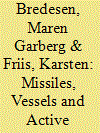| Srl | Item |
| 1 |
ID:
178271


|
|
|
|
|
| Summary/Abstract |
In 2019, Russia’s Chief of the General Staff, Valery Gerasimov, presented a ‘strategy of active defence’, a possible prelude to the forthcoming Russian military doctrine. This article examines this strategy with particular emphasis on the role of precision-guided missiles, tactical nuclear weapons and the role of the navy. It provides insights on the shape of new Russian military doctrine and the military threat Russia might represent to the West. Maren Garberg Bredesen and Karsten Friis conclude that the active defence concept may imply a lowering of the use-of-force threshold. Russia’s continued build-up of tactical nuclear weapons integrated into the conventional forces reinforces this concern.
|
|
|
|
|
|
|
|
|
|
|
|
|
|
|
|
| 2 |
ID:
093884


|
|
|
|
|
| Publication |
2010.
|
| Summary/Abstract |
This article demonstrates that there are more similarities between peacekeeping and counter-insurgency than often recognized. In today's 'war among the people', the counter-insurgent cannot succeed with offensive military capabilities alone and must seek to apply also non-kinetic and defensive methods; whereas the peacekeeper often is forced to apply 'robust' and kinetic means to implement a mandate. As a result, the two concepts seem to be converging and share some commonalities. The article compares the UN Department of Peacekeeping Operations 'capstone doctrine' and the US Army Counterinsurgency Field Manual to argue that the two doctrines share similarities in six areas: (1) a focus on civilian solutions; (2) a need for protection of civilians; (3) international coherence; (4) host-nation ownership; (5) use of intelligence in support of operations; (6) limitations on the use of force. The article suggests areas where the two doctrines could mesh with each other.
|
|
|
|
|
|
|
|
|
|
|
|
|
|
|
|
| 3 |
ID:
113335


|
|
|
|
|
| Publication |
2012.
|
| Summary/Abstract |
Ten years of international intervention in Afghanistan-why has so little been achieved? This fundamental question cannot be answered by focusing only on certain key actors, such as the armed forces. It requires a holistic analysis that covers several sets of actors and various sectors of the intervention. The analysis must also go beyond the day-to-day issues of coordination and resource allocation, and look into the basic questions of how the different sets of actors ascribe meaning to Afghanistan and themselves: their identities. What is the purpose of their being (there)? This article proposes to apply discourse analysis, not taking identities and meanings as a given, but focusing instead on the constitution of identities. By analyzing the military, humanitarian, and state-building identities in Afghanistan through their spatial, temporal, and ethical dimensions, the article seeks to demonstrate the utility of this approach for studying interventions, and to provide preliminary answers to why the results in Afghanistan have been so meager. The Western interveners have been struggling internally over a myriad of conflicting representations of Afghanistan and the Afghans; are in denial of their own power of dominance and political influence over the Afghan "other"; and refuse to recognize the political role and power of the Afghan other. Lastly, as changing the other will also ultimately change the "self," the former is circumvented, to ensure the preservation of the intervening self.
|
|
|
|
|
|
|
|
|
|
|
|
|
|
|
|